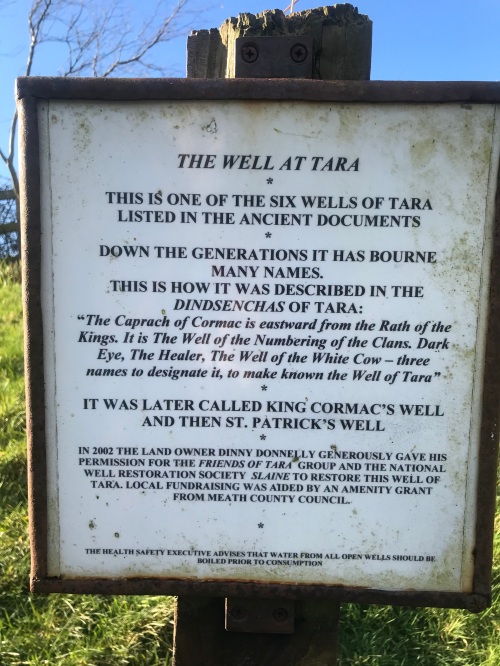| Place | Painting No. | Date |
| Tara The Well At Tara | “(1C)” | 29/Sep/23 |
| Spiritual/Esoteric ref | Gaeilge | Etymological Root |
| The Well of The numbering of The Clans, Dark Eye,The Healer, The Well of The White Cow . | Teamhair Tea Mur | The Burial place of Tea |
| City | The Four Treasures | Properties | Christian/ Jewish/ Egyptian Equivalents | Tarot Suits |
| Falias | Stone of Fál (Lia Fáil) The speaking stone or stone of Destiny. | It would cry out beneath the king who took the sovereignty of Ireland.and who held the Sword called Fragerach. It was supposedly located near the Hill of Tara in County Meath. | The Altar or Cornerstone. Jacobs Pillow. The Alar of The Holy Lamb. | Coins, Discs or Stones |
| Goirias or Gorias | Spear (sleg) of Lugh | No battle was ever sustained against it, or against the man who held it. | The Sceptre, Rod or Crook of the pharaoh or , The Good Shepards Staff, The Staff of John the Baptist. The Pilgrims Staff , The Crozier, The rod of Moses , Staff of The High Priest , The Druids Staff. The Caduceus. The Spear of Longinius. | Wands, Spears or staffs |
| Findias or Finias | Sword of Light (claideb/claiomh solais) which belonged to Núada and Lugh | The Fragerach, no one ever escaped from it once it was drawn from its sheath, and no one could resist it. The sword is also described in the Tain legend as “Nuadu’s Cainnel”—a glowing bright torch . Nuada passed the sword on to Lugh | The Sword of Truth which emanates from the mouth of The Son of Man or is held by an archangel | Swords |
| Muirias or Murias | Cauldron (coire) of the Dagda or cup | No company ever went away from it unsatisfied (also known as the Coire Ansic). | The Grail , Sang Real, Sangraal the cup of the last supper brought to Glastonbury at one time by the son of Joseph of Arimathea the man who is called Joseph of The Holy Family of Jesus | Cups |
The most important Ideas surrounding The legend of The Holy Grail is that it is a cup used by Jesus at the Last Supper and that it was also amongst his belongings left to his family when he died. It is a store of Grace for the world. It’s an idea that flourished in Europe in medieval times. We will come back to this again . But instead for now let’s go back to the source of a much later aspect of this incredible cross cultural narrative.
This centres initially around one figure. His real name was Owain Ddantgywn and they called him “the bear”. Apparently King Arthur’s full title was from the word for bear in two languages side by side was given as Arthursus : Arth meaning Bear in Brythonic (early welsh) and Urus meaning bear in Latin (the language of the Romans ) This was then shortened to – Arthur. Just to be thorough about it. The name “Pendragon” just means Head Dragon. So his legendary name means something like “The bear head-dragon” this was his popular title . But his birth name was Owain Ddantgwyn. He ruled after the romans had left Briton and his first name, Owain, can mean numerous things including …..noble born, youth or “born of the yew “ or even “sheep kin”! His second name in early welsh translates as “White Tooth”. This last meaning does present an interesting correlation with the title “Bear“. Bears did in fact roam Ireland and the UK back in those days hunting down deer before they were driven into extinction here along with wolves .

As in the artificial construct of the legend of King Arthur, Owain Ddantgwyn also fights at the head of the Britons in a battle against the Anglo Saxons which in legend is known as the battle of Badon Hill.
It took a lot of research into early English history for historians Graham Phillips and Martin Keatman authors of “King Arthur , The True Story “ to find out who Arthur actually was, but what mostly emerges after reading this book is the realisation that the modern idea of King Arthur is an evolution of an idea of a personality and that most of the legends surrounding him have tagged on to this identity like pins to a magnet.
He was a real life warlord but was nothing like the knight in shining armour that he was portrayed as in legends such as the “Morte D’Arthur” by Thomas Malory. Indeed they didn’t have armour like that in the years he was alive and during the time he actually reigned from 488 to 520. His true Camelot was based at Viroconium which is currently modern day Wroxeter a small village in Shropshire England between Birmingham and Welsh Snowdonia . He successfully repelled the Irish from the isle of Anglesey (somewhat ironically as this is where many Irish travel to today to get their ferry to Holyhead and travel into the UK) . Up to the time of those years the Irish were politically and militarily more powerful than than the English .
Where do these legends come from?
As I said , These legends are like pins, as I think of them, that are stuck on to the magnet of the King Arthur title. They are actually sources from celtic legends which come from Wales, Cornwall , Scotland, France, Germany and … of course, Ireland. These stories have been gathered by the intelligentsia who recorded the european romances (though there was no idea of ”Europe“ per se then when they were composed ).
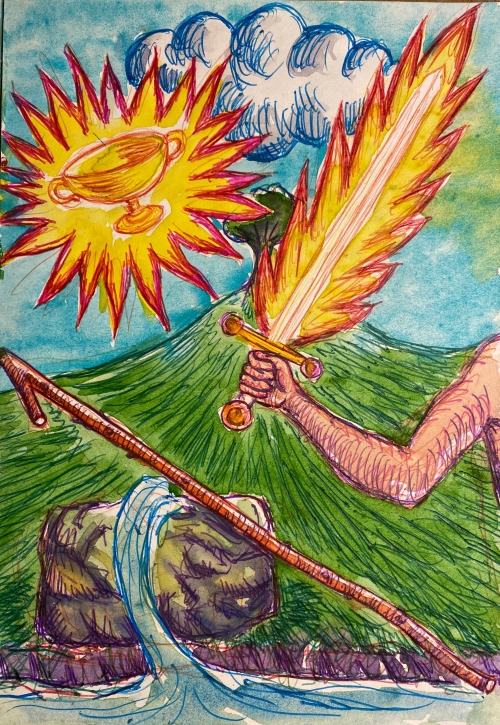
What they were interested in doing was using these stories to transport what the church would regard as heretical gnostic myths, magical and pagan beliefs and encode them within this legend or corpus of fairy tales. What resulted is a reworked story for medieval readers. A story that conveniently becomes political propaganda for the new idea of England as was being promoted by monarchs and their vassals at the time of the writing of these ideas. This also becomes a subliminal influence for the nobles in favour of its monarchy and “the divine right of kings” which embodies the idea of a bloodline going back to the family of Jesus Himself.
As well as this and for those who are aware of the deeper meanings of the symbolism, the stories function as an introduction to alternative religious beliefs many of which were regarded as dubious by the Catholic Church.
This is not an unusual practice and it has been around since the origins of mythology itself. In more recent centuries the same was done with the stories that became “Snow White and the Seven Dwarves” and “Pinocchio”. Perhaps most relevant to that discussion is the story of “The Little Mermaid” which finds its true meaning within its reference to the encoded Grail legend pertaining to the link between the Merovingian kings and the descendants of Jesus and Mary Magdalene . That’s a whole other story and very much worth looking into as this reveals where the idea of a “divine right ” comes from on the European continent and France in particular.
The Bloodline
To touch lightly upon it here. In research about the Grail there are various references to a woman who comes from the sea and the story of the little mermaid is a reference to Mary Magdalene that freemasonry is aware of. There is a very good book by Margaret Starbird called “The Woman With The Alabaster jar” about this symbolism . It explains a lot of the symbolism used to transmit gnostic ideas. Images like the use of the bee in Merovingian royal symbolism in coats of arms and watermarks for instance. The word Merovingian relates the the Sea as in French “Mer”. In particular to one of the first Merovingians “Merovech” . The Chronicle of Fredegar recounts that Merovech was born after Chlodio’s wife encountered a sea creature while bathing in the sea. This legend contains a grain of truth, that the Merovingian kings married into the descendants of Jesus who came from across the sea. French artists such as Jean Cocteau refer to the idea . This was one of the attraction for him and many artists to come to the south of France. This continues into modern times with Bob Dylan visiting Sainte Maries de la Mer to write his song inspired by the visit called “One More Cup of Coffee”. Sainte Maries de la Mer is where the Holy Marys of the Sea (Mary the Mother of Jesus and Mary Magdalene) and an Egyptian dark skinned servant called Sara land in France having travelled to escape persecution in The Holy Land . The Gypsies of Europe gather there every year in the Camargue on the 24th and 25th of May . The word Gypsy comes from the word Egyptian
Starbird mentions, and it is true, that a Disney movie even referred to Mary Magdalene in their animation of 1989 “The Little Mermaid” by showing a de la Tour painting of “Magdalene with the Smoking Flame” in a scene from the movie in the grotto where Ariel sings “Part of Your World”. I simply have to also mention that the Hebrew name Ariel means “Lion of God”.
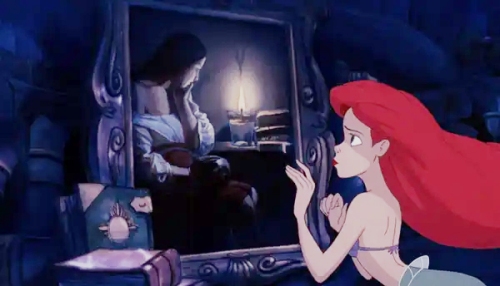
The Celtic Renaissance and The Image of The Grail .
In Ireland when the Celtic legends were again reassembled during the Irish Celtic revival led by well known Irish writers and patrons from the protestant ascendancy class such as W.B. Yeats , Maud Gonne and Lady Isabella Augusta Gregory. They also imbued their retelling of these stories with their own understanding of mysticism and magic drawn from their own involvement with deeper interests they pursued such as Yeats now well known involvement with The Hermetic Order of The Golden Dawn .
Contrary to the impression we were given by our Irish education system when I was young , though many of their concerns were political and material , their agenda is complicated and although it is wrapped up in the dressing of mysticism and magic, their objectives had material goals and were consciously part of an effort to create a cultural soil within which the seeds of Irish revolution could grow. This was supported by a sincere practice of magic where rituals were conducted and believed to have been effective in helping them meet their aims and help them to attain status. Yeats for example as we know was a complex and determined individual who had views, that though less understood at the time, were clearly in conflict with Catholic orthodox ideas about goodness and sometimes obviously politically questionable (for example his ideas expressing leanings towards a fascist nationalism)
But to get back to the main point.
Other research reveals that The Grail Legends as revived in French, Welsh and English Literature are actually often a Christianised appropriation of Celtic legends. Many of the stories find their roots in Celtic documents. For example The cauldron of the Dagda ( whose name is translated as the ‘good god’ or ‘shining god ’) and the Sword of Lugh are actually partly the basis for the inspiration for the idea of the Grail and Excalibur. Though the interweaving has been carefully concealed, it remains to be true.
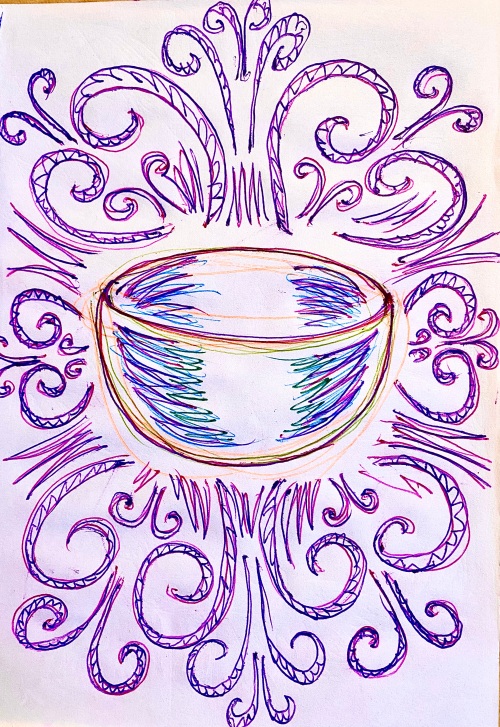
The Dagda carried the bottomless un-dry cauldron known as the “Coire Ainsic”. Any one who came to it never left unsatisfied. The good god Dagda (which is what his name means ) who is also known as Eoachaid Ollathair (Horseman , All- Father ) himself was portrayed not unlike The Fool in the Tarot Deck with a tunic that barely covered his exterior leaving his behind exposed and carrying a club or stick (or rudely dragging his huge penis along the ground) . But this is not consistent with his image as also the cultured player of the “Uaithne” the oak harp that he carried with him to call forth the seasons or the order of battle . The Morrigen was known as his “envious wife” and one of his daughter’s was Brigid a name which was later christianised to become St Brigid whose feast day is the first day of spring, February the first . His image was tampered with by christian translators. He appeared on the face of it to be a primitive but happy fellow but he is associated with giving life and sustenance and was for a time in the tales the most important God until he was replaced by Dalbáeth (enchanted Fire ) who’s daughters Eriú, Banba and Foladh The Triple Goddess’s came to rule Ireland with one of them giving Ireland its modern day Irish name.
Cuchulainn and his friend Cu-roi go on a search for the Dagda’s cup and not unlike the later stories about the fisher king they find it in a mysterious castle. Manannán Mac Lir the warrior king of the otherworld known also as the isle of the blessed, kept the Cup of Truth in the Mag Mell (plain of honey ), the Tír Tairngire (The Land of Promise ),the Emain Ablach ( Emain of The Apples, these are the sacred apples kept on Manannáns Island known today as the Isle of Man or The Aran islands depending on which story you read , perhaps he owned both?).
Another reference to a cup with special powers is in the story of “His Three Calls to Cormac” . When Manannán arrives at Tara with a silver branch with nine red gold apples upon it with the power to take away all sorrows. Cormac takes it as a gift without realising its significance. For Manannán comes back three times and each time calls away the daughter, his son and finally his wife to the Land of Promise. Cormac follows him and after various adventures Cormac is shown the cup of Truth which splits into three pieces if a lie is told over it… and it joins back together when a truth is told over it. Having gained back his family Cormac finds themselves back in Tara as if they had travelled in a dream to the Isle of The Blessed briefly.
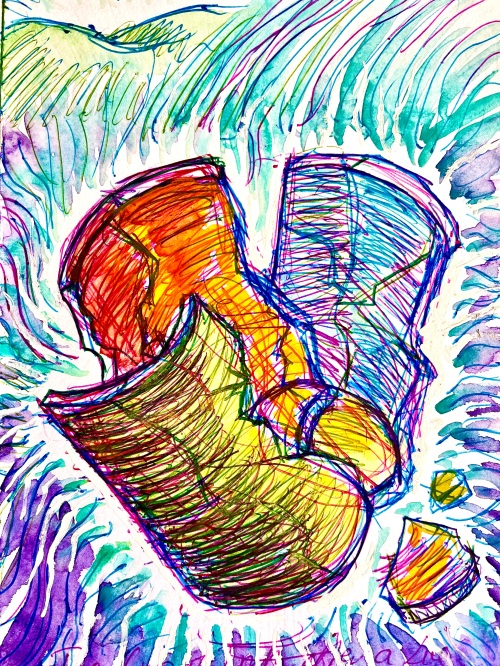
A similar occurrence happens when in the story of “Ailines Revenge” Finn, Daire, Oscar, Conan and the Fenian men find themselves lost in the middle of a mysterious Druid mist when they are cruelly imprisoned with all their strength sapped from them by the Grey Man and Ailine in whose Dun they suddenly find themselves. It is not until they are allowed to drink from the enchanted gold cup of Ailine that they are allowed to finally break free when they awake to find the dun has disappeared and they are left lying sleep on the bare grass in the dew.
In the story of “The Hidden House of Lugh” , after Lugh is killed, some say at Uisneach, he is succeeded by The Dagda and he is seen again a number of times. On one of those occasions he is seen by Conn of a hundred battles when he is having a discussion about The Lia Fail with his Druid. As in other stories a mysterious mist descends upon him and he is brought to a beautiful plain where he comes across a kings rath with a golden tree and a house with a roof of white bronze. There he meets a young woman with a golden band about her head who has a number of serving vessels, among them a golden cup . She serves a drink to him in it and he is told that she is “The Kingship of Ireland Forever” and his host , the master of the house turns out to be Lugh of the Long Hand, son of Eithlin himself.
The Celtic Connection in France.
In these stories we find a significant preoccupation with the idea of a cup that holds special powers and as we come to the time when Christianity spreads outwards from Rome and North Africa and the middle east ( the last two being where its less orthodox strains are often found ). It is not hard to find a natural syncretism occurring between the idea of the special celtic cup and the story of Jesus and the cup used during the last supper. This association was to be particularly well preserved in southern France where is it said that Mary the Mother of Jesus, his wife Mary Magdalene and their son came in order to escape the authorities.
But it must be remembered that these places where the story of The Grail is associated with were previously celtic strongholds anyway. The templar chateaus were built upon celtic duns or forts. Montesgúr and Rennes Le Chateau for example where I have visited in the Languedoc were both obviously built upon the ancient foundations of celtic strongholds before their chateaus were raised . These areas would have had strategic importance overlooking as they do the Pyrenees. The Crystal Path, as I call it, finds important centres along these old celtic roads and it intersects in places like Axat in Aude, the Narbonne and Lugdunum (named after the celtic god Lugh and now known as Lyon).
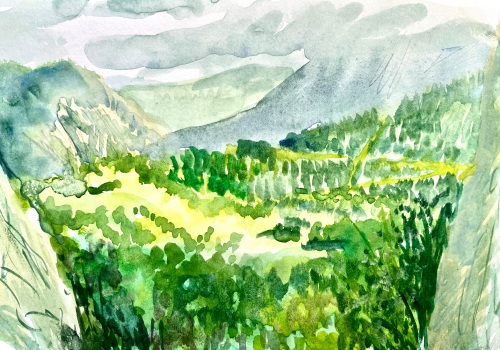
Montsegur has numerous Grail legends associated with it and there are grail legends connected the Christian / Judeo religion of Catharism among a people who kept some of these legends alive in times of persecution by the orthodox Catholic Church. Particularly the “heretical” stories about Mary Magdalene as an apostle /teacher figure and the link between the descendants of Jesus and their eventual marrying into the Merovingian bloodline. The Grail legend and its unstoppable mythology survives right up to today in the minds of people who question the official version of events surrounding the The Life of Jesus and so, ideas about the Grail persist into modern times.
The Consistent Fascination with The Grail in Cultural Exploration:
In the Belle Epoque in France before the turn of the century there was a revival in spirtualism and a movement of interested parties in various aspects of The Spirit World , symbolism, eastern and other lesser known religious and mystical beliefs. Interest in the Grail also was intense with different societies such as the inner circle of the Hermetic Order of The Golden Dawn looking for it and any object that was of spiritual or psychic importance. This period also coincided with the development of Art Nouveau , Symbolist Art, Early Surrealism and modernism. This is no coincidence, Modern art as we came to know it arose out of the stylistic movements begun during the Belle Epoque . This fact is only beginning to be understood. It was formed from preoccupations with magic and mysticism, have no doubt about that. Its ideas spread to the rest of Europe and Irish artists and writers too were drawn into its agenda. Archeologists began to look for evidence of sacred artefacts and I related elsewhere the story of the British Israelites visit and their sacrilegious dig at Tara.
A later example of this search for the grail was Otto Rahn, a German medievalist who wrote a book entitled “The Crusade Against The Grail”. In it he attempted to link the ideas from medieval Grail Romance of Parzival with ideas that the Cathars were wiped out because of their knowledge of its existence and the rumors of a bloodline coming directly from Jesus which were seen as a threat to the churches dogma. Rahn came to work for the Nazi’s SS “Race and Settlement Main Office” conducting his research further there visiting the Cathar regions of Montsegur searching for the Grail on behalf of the Reich coming to a mysterious death when he fell out of favour with the Gestapo, eventually being assigned to guard duty at Dachau concentration camp for failing to keep his homosexual behaviour discreet and failing to find the Grail. Said to be shocked when he saw the appalling atrocities there he “resigned” from the SS. This is often a euphemism that would mean he was expected to commit suicide . He was later found dead in the Tyrolean mountains in Austria . There has been much speculation about this. it may have been suicide, murder or even a faked death. It is just one of many stories that illustrate the importance of the idea of the Grail. No doubt whoever was seeking it from that quarter wanted to destroy it.
The Grail in The Writings of Brian Cleeve
This is a long way from the story of Joseph of Arimathea the son of Joseph of Arimathea (who is the same as the Joseph of the Holy Family of Jesus) . Joseph like St John was an Essene and was with him on the island of Patmos where John wrote his gospels and Revelation. John had taken The Grail there with him and after he died he gave it to Joseph who travelled to Rome with it after running into conflict with the Church of Rome. This was because the inner teachings Jesus taught as given to him by John that Joseph tried to teach were not understood and he had to flee to Marseilles and from there to Avignon. There the inner teachings were accepted by a small community of Jews who were Essenes also. They accepted them and were converted. A small number of them travelled with him with The Cup to Britain and onto Glastonbury after they were denounced by the followers of the more popular version of christianity as taught by Peter and Paul. In Glastonbury The Grail is kept safe for a time until……
Well, this history of The Grail is recorded in more detail in the books of Brian Cleeve written in Ireland and you can find out more about this aspect of things here at http://sevenmansions.org in his book The Seven Mansions and his chapter upon The Holy Grail. There is also an essay entitled “The Worlds Need” about The Grail which can be found there as well. The idea that the Grail travelled to Britain and was kept safe in Glastonbury is well known and was celebrated in the art work and poetry of William Blake and an interesting reference to it can be found in the frescos of Michelangelo (a reference where Blake get his visual inspiration from). Looking at those images one can only surmise that he is holding The Grail hidden in his arms.
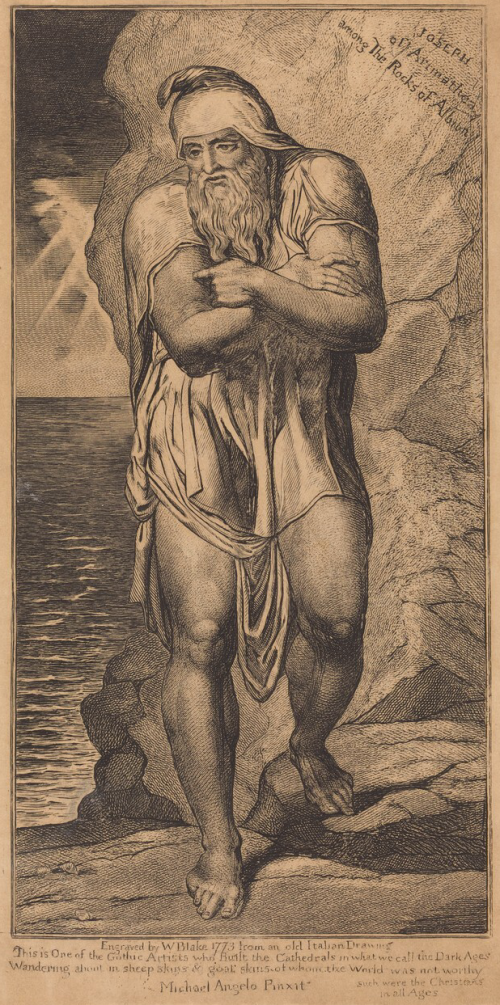
The image of Jesus at one time holding in his own hands a small earthenware cup a krater in the greek style that he picked up in a local market in Capernaum has taken on some substantial poignancy for those who wish to see in their minds eye a living mortal man who like every other human alive needed to drink water to survive as he walked the hot dry roads of Galilee. This man can be envisioned by anyone as a living presence wherever they are in the world and what can fascinate us is the idea that objects connected with The life of Jesus may have travelled to different parts of the world to become part of our own life in places we are familiar with or perhaps to symbolically take on meanings which are layered over layers enlivening our imagination and stirring the mysterious and spiritual within us perhaps even allowing us to envision a Living God here and now with us in the world with a cup that channels His Grace towards us.
And On To Tara
At Tara (Teamhair) a series of ringforts and mounds and other features is a place which is believed to have links with the middle east being named after a princess who is either Egyptian or Jewish. Why this legend persists I do not quite understand but it has been mentioned so often in various readings such as the mention of her name in the Lebor Gabala Erin, the book of the taking of Ireland . One has to open their mind to the fact that there might be some truth to it. One version of it tells us about how Ebers wife wanted him to take the three most beautiful hills in Ireland for her . Unfortunately one of the hills did not belong to Eber but to Eremon. Eremons wife Tea was angered and this started a battle between the two leaders during which Tea herself was killed She was then buried in the hill . From that time the place was then known as Teamhair or Tea Mur meaning the burial place of Tea. There is also another version of the story where she is said to be a Spanish princess. Today a small church stands at the entrance. Yet another example of the close relationship between christianity in Ireland and celtic traditions. This it leads me to another idea.
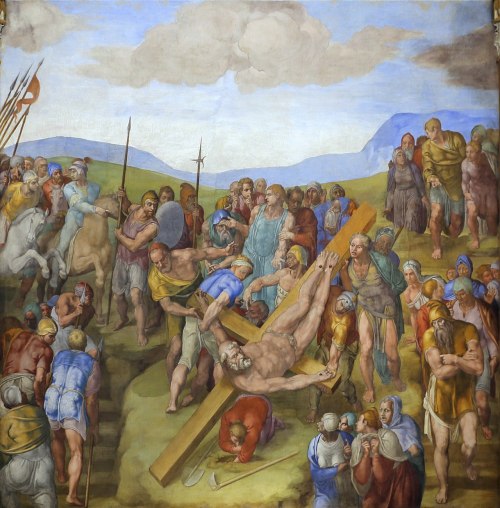
The Smooth Transition from Celtic to Christian Symbolism:
Our knowledge about such things appears to come to us from the “Culdees” the wise men or sages that inherited the knowledge of the monks and the Druids after the coming of Christianity. What sort of version of Christianity came first to Ireland we do not tend to hear about. But the transition appears to have been smooth. This can only be for one reason as far as I can tell. There was an agreement of some kind that allowed elements of druidic beliefs to merge with early christian ones, for both traditions to tolerate one another .
For some reason there was no known resistance to the coming of early christianity in Ireland . I have not heard yet of any persecution of Christianity in Ireland. Except by christians upon other ones. And it is clear from the dates given that it had arrived before Patrick who came to standardise it and incorporate it in the Roman Orthodox organisation. I often wonder if Patricks mission to establish Peter and Pauls vision of Christianity which arrived later than other missionaries such as Palladius, was really to counteract the effects of a pre-existing version of Christianity? Did followers of Joseph reach Ireland before Patrick did ? Having lived peacefully without conflict in Glastonbury with their version of the inner teachings of Jesus , did they convert local religious leaders and persuade them to accept their understanding of Christianity? Having had success did they for a time manage to spread their ideas amongst the first Druids to be converted? Did this sophisticated druidic network help spread the teachings first through Wales, into Scotland and Ireland ? Finally was this why the earliest form of christianity to appear in Ireland have its own unique iconography and unorthodox imagery?
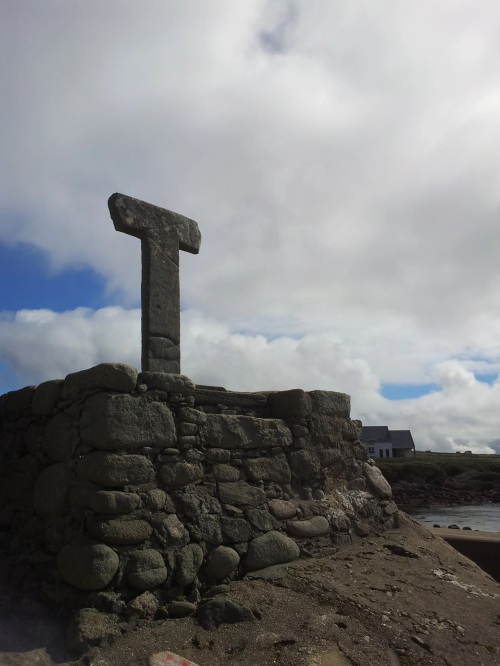
The presence of the Tau Shaped Cross form in ireland at 9 locations indicates to me a different style or system of gnostic christianity having been accepted before a roman version became the prevailing version as symbolised by The Latin Cross. It is fashionably referred to as celtic christianity now. The idea that the cross was T shaped is consistent with some of the earliest christian iconography that may have reached ireland through its international trade routes that we know even had connections with the middle east through the copper and tin trade. We also know of boat design and music particular to the west of Ireland that appears to have taken their inspiration from what we might today call Moroccan and Arabic influences. There was a strong celtic network of pathways across Europe before the Romans came. When you look at the centres of christianity that sprung up along these same druidic routes one has to ask the question again was there a spiritual alignment as well as a physical one?
More evidence for a spiritual alignment.
The well at Tara is just one of many thousands 2996 of wells across southern Ireland and 187 officially recognised in Northern Ireland (probably much more there than that) . Many, if not all of them were originally part of pagan sites where often the goddess of that area was remembered in association with whatever healing property the well had. Here is another easy alignment between the celtic beliefs of the past and the beliefs of early christianity. Because almost all of these wells that I have ever come across, are now named after christian saints or figures . Often they are named after saint Brigid whose own story is intermingled with that of the Irish Goddess Brigit. Of course some are named after Our Lady, others after St Patrick and so on. The importance and the sacredness of water within celtic and Grail legends show a preoccupation with its image as a substance that in some way may transmit Grace through healing or favours granted. To this day the practice of tying a piece of cloth belonging to the person requesting the favour is still carried out at these sites as can be seen in the photo here.

The ancient wells of ireland having sacred, life renewing and healing properties are traits that goes back to its pre christian designations. It is another example of the smooth transition between paganism and christianity . The different names that continue into modern use for The Well of Tara , such as The Well of The White Cow (another image of life giving sustenance ) or even the title “Dark Eye” (perhaps hinting at a possible cure for blindness ) tell of modern day belief in its powers. The White Cow is another name for Boann. The Goddess of The Boyne River which is nearby . I will cover this connection in much more detail in part 2 of this 4 part series.

With the story of Arthur and The Grail I hope I have shown is a perfect example of that. The idea that The Grail contains miraculous healing powers through the Blood of The Living God contained within is merely a natural continuation of the very real human link with the otherworld . The image of Grace emanating from The Body Of Jesus as embodied in The Grail becomes an expression of reality in mystical terms for anyone seeking that higher level of existence and obtaining the holy substance thereof.
